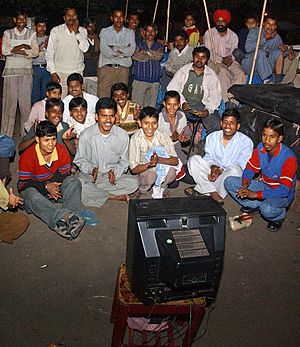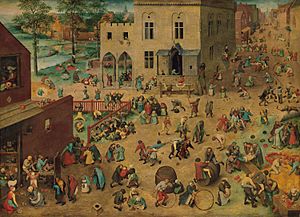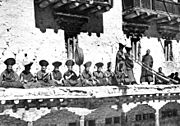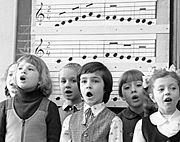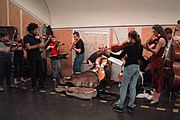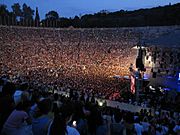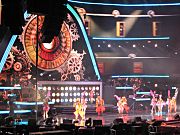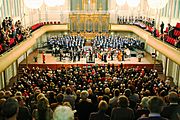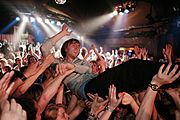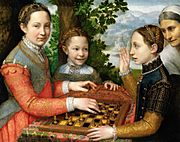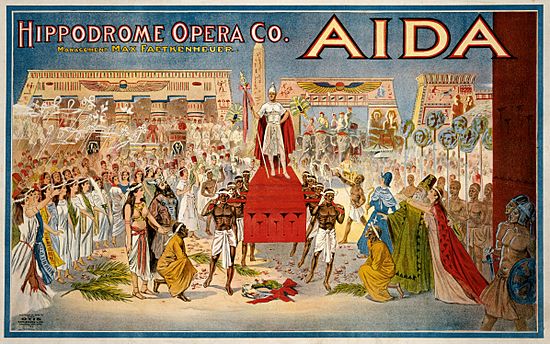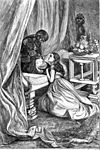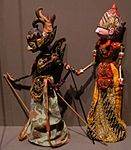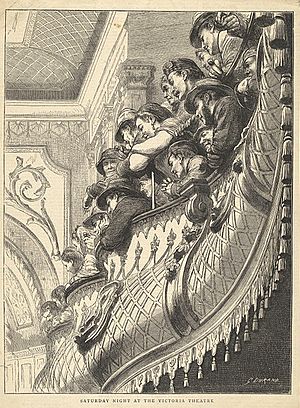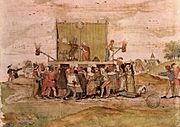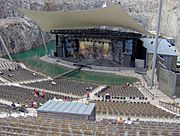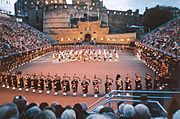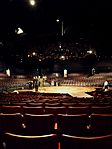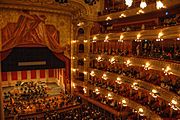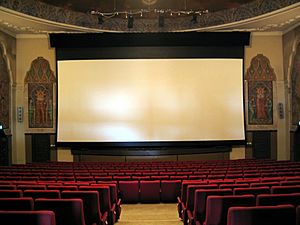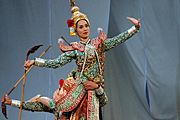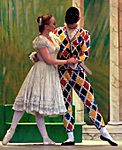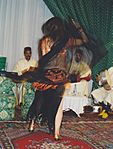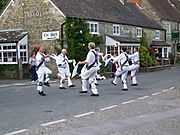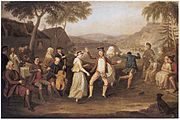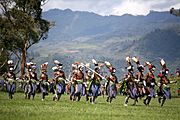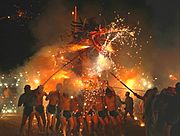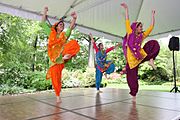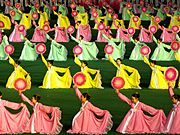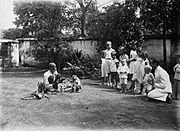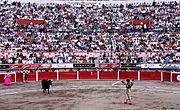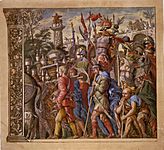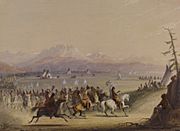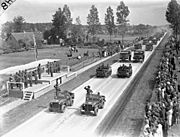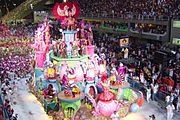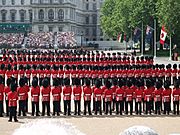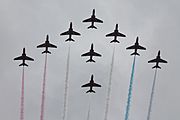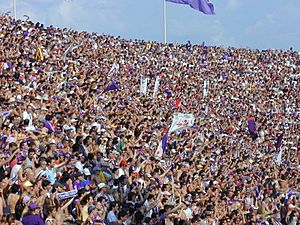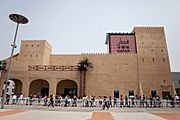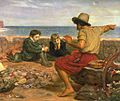Entertainment facts for kids
Entertainment is anything that grabs your attention and makes you feel happy or interested. It can be an idea or a task, but usually, it's an activity or event that people have created over thousands of years just to keep an audience entertained. Even though everyone likes different things, many types of entertainment are well-known around the world.
Things like storytelling, music, drama, dance, and other kinds of performance are found in every culture. Long ago, kings and queens enjoyed these in their palaces, and over time, they became available to everyone. Today, the entertainment industry makes it even easier to enjoy these things by recording and selling them.
When we think of entertainment, we often think of amusement and fun, like laughing. But many types of entertainment can also have a serious purpose. For example, some ceremonies, celebrations, festivals, or satire (funny criticism) can be entertaining but also teach us something or make us think. So, entertainment can sometimes help us learn and grow.
A big part of entertainment is having an audience. This is what turns a private hobby into something for others to enjoy. The audience can be quiet and just watch, like when people see a play, opera, TV show, or movie. Or, the audience can be active, like in games, where players might also be watching each other. Entertainment can be public, like a theatre show or concert, or private and spontaneous, like children's games. Many forms of entertainment have changed over hundreds of years because of new cultures, technology, and trends. For example, movies and video games use new technology but still tell stories, show drama, and play music, just like older forms of entertainment.
Entertainment for Kids
For kids, entertainment is mostly about play. Playing is super important for how children grow and learn. Adults also provide or teach entertainment to children. Many activities that kids love, like puppet shows, clowns, and cartoons, are also enjoyed by adults.
Kids have always played games. It's clear that playing games is not just fun, but it also helps children develop. A famous painting by Pieter Brueghel the Elder called Children's Games, painted in 1560, shows kids playing many games that were common back then. Lots of these games, like marbles, hide-and-seek, blowing soap bubbles, and piggyback riding, are still played today!
Most types of entertainment can be changed to fit what kids need and like. In the 20th century, experts like Jean Piaget helped us understand that children's minds develop in stages, and they think differently from adults. Because of this, stories and activities in books, movies, or video games were made especially for kids. Countries have even created systems, like television content rating systems, to help guide families and the entertainment industry about what content is suitable for different ages.
Today, lots of entertainment for kids is available online for them to enjoy privately.
Types of Entertainment
Reading for Fun
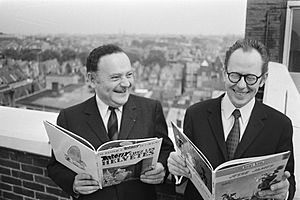
Reading has been a fun way to be entertained for a very long time.
Many kinds of literature are made just for entertainment. For example, limericks are funny poems with a strict rhyme and rhythm that make people laugh. Books where you "choose your own adventure" let you be part of the story, making reading even more interactive and entertaining.
Comics and cartoons are types of stories that use drawings or pictures, often with words, to tell an entertaining tale. Many modern comics have fantasy elements and are made by big companies in the entertainment industry.
Music to Enjoy
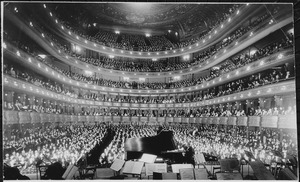
Music is a key part of many types of entertainment and performances. For instance, it makes stories better, is essential for dance and opera, and is usually in movies or plays.
Music is also a super popular form of entertainment all by itself, like when people go to concerts. Music has many different styles, depending on its rhythm, instruments, and how it's performed. Some examples are classical, jazz, folk, rock, pop music, or traditional music. Since the 1900s, recorded music has become very cheap and easy to get, thanks to the entertainment industry broadcasting it or selling it.
All kinds of music shows, whether they use loudspeakers or not, are entertaining. This is true whether it's a solo singer, a choir, an orchestra, or a small group. Live shows happen in special places, which can be small or large, indoors or outdoors, and cost money or be free. Audiences have different expectations. Some just want to listen quietly and enjoy the amazing music. Others enjoy the atmosphere and like to sing along or dance. Many people also enjoy pre-recorded music privately, like with headphones.
Music uses either just the human voice, only instruments, or a mix of both. Performers can be solo artists or part of a group, entertaining an audience that might be just one person, people passing by, a small crowd, or a huge crowd. Singing is usually with instruments, but some styles, like a cappella, are without. Modern concerts often use cool special effects and other theatrical tricks with singing and dancing.
- Musical entertainment – 10 types of audience engagement
-
3 Ensemble entertains travellers in the Paris Métro (2002)
-
5 Choir and orchestra in ecclesiastical setting (Italy, 2008)
Fun with Games
Games are played for fun, sometimes just for entertainment, and sometimes to win or get a prize. You can play them alone, with teams, or online. Players can be amateurs (just for fun) or professionals. Sometimes, people watch others play games, like a chess championship. Other times, players are their own audience as they take turns. For kids, part of the fun is often deciding who gets to watch and who gets to play.
The things you need for games change with each game. Board games like Go, Monopoly, or backgammon need a board and pieces. One of the oldest known board games is Senet, played in Ancient Egypt by pharaohs like Tutankhamun. Card games like whist, poker, and Bridge have been popular evening entertainment among friends for a long time. All you need for these is a deck of playing cards. Other games, like bingo, are played with many strangers and can involve gambling. Many games are made for children and can be played outdoors, like hopscotch, hide and seek, or Blind man's bluff. There are also many ball games, including croquet, lawn bowling, and paintball, as well as many sports using different kinds of balls. These games suit many different skill and fitness levels. Physical games help you become more agile and improve your motor skills. Number games like Sudoku and puzzle games like the Rubik's cube can make your brain sharper.
Video games are played using a controller to make things happen on a screen. You can also play them online with people from far away. In the last part of the 1900s and in the 2000s, the number of video games grew a lot, giving players worldwide a huge variety of entertainment. Video games are very popular in East Asian countries like South Korea.
- Games
-
Sofonisba Anguissola
The Chess Game (1555)
An intellectual game -
Théophile Emmanuel Duverger (before 1901) Hopscotch
A physical game -
Televised match of StarCraft (2006) South Korea
An electronic game
Live Performances
Live shows in front of an audience are a huge part of entertainment, especially before people could record audio and video. Performances come in many forms, like theatre, music, and drama. In the 1500s and 1600s, European royal courts had "masques," which were fancy theatre shows with dancing, singing, and acting. Opera is a similar type of performance that is still popular today. It also combines all three forms, needing great musical and acting skills, teamwork, and expert production.
Audiences usually clap to show they enjoyed a performance. But performers always risk not keeping their audience's attention. If an audience isn't happy, they can be very clear about it!
Telling Stories
Storytelling is a very old way to entertain, and it has influenced almost every other form of entertainment. It's not just fun; it also helps us think about human problems and feelings. So, while stories can be told directly to a small group, they are also a key part of anything that has a plot, like movies, plays, ballets, and operas. Written stories have been made even better with illustrations, sometimes very artistic ones, like in old illuminated manuscripts or Japanese scrolls. Stories are still a common way to pass the time and entertain people who are traveling. For example, Geoffrey Chaucer used pilgrims telling stories in his book The Canterbury Tales in the 1300s, and Wu Cheng'en did the same in the 1500s in Journey to the West. Even though we travel much faster now, stories are still told to passengers in cars and planes, either by talking or using technology.
The power of stories to entertain is clear in one of the most famous tales: Scheherazade. This story, from the Persian tradition of professional storytelling, is about a woman who saves her life by telling stories. The way stories inspire new entertainment forms shows how different types of entertainment are connected. For example, composers Rimsky-Korsakov, Ravel, and Szymanowski were all inspired by the Scheherazade story and turned it into orchestral music. Director Pasolini made a movie based on it, and there's even an innovative video game about the tale. Stories can also be told without words, like through music, dance, or puppets. Examples include the Javanese tradition of wayang, where a show is accompanied by a gamelan orchestra, or the traditional Punch and Judy puppet show.
Epic stories, poems, sagas, and allegories from all cultures tell such exciting tales that they have inspired countless other stories in every form of entertainment. Some examples are the Hindu Ramayana and Mahabharata; Homer's Odyssey and Iliad; the first Arabic novel Hayy ibn Yaqdhan; the Persian epic Shahnameh; the Sagas of Icelanders and the famous Tale of the Genji. Collections of stories, like Grimms' Fairy Tales or those by Hans Christian Andersen, have also been very important. These folk stories, first published in the early 1800s, still greatly influence today's popular culture, which uses their ideas, images, and structures to create new entertainment.
Some of the most powerful and lasting stories are the origin or creation myths, which explain how the world began. Examples include the Dreamtime myths of the Australian Aborigines, the Mesopotamian Epic of Gilgamesh, or the Hawaiian stories about the world's creation. These stories are also turned into books, movies, music, and games, which helps them last longer and makes them even more entertaining.
- Telling stories
-
William Blake's painting of the pilgrims in The Canterbury Tales
-
Scheherazade telling her stories to King Shahryar in The Arabian Nights
-
Telling stories via Wayang golek puppets in Java
-
Tosa Mitsuoki illustrating her Tale of Genji
Theatre Shows
Theatre performances, which are usually plays or musicals, happen on a stage for an audience. Theatre has a long history, going back to ancient times when musicians and actors performed at competitions. Famous thinkers like Aristotle and Plato even wrote about what theatre is for. Rich people in ancient Rome also put on very fancy shows.
Plays, musicals, monologues (one person talking), pantomimes, and performance poetry are all part of theatre's long history. This is also where you find stand-up comedy. In the 1900s, radio and television (often live) continued the theatre tradition, even as new forms of entertainment appeared.
A theatre is made up of the stage and the seating area for the audience. Stages can be simple or fancy, temporary or permanent, indoors or outdoors. The skill of getting the stage ready for a show is called stagecraft. How much the audience enjoys the show depends on what they expect, the stagecraft, the type of stage, and how comfortable the seats are.
- Theatrical entertainment – stages, staging and stagecraft
-
6 An outdoor theatre made from the front area of Edinburgh Castle.
-
7 A traditional stage for Japanese Noh theatre.
-
9 Teatro Colón, a very fancy, horseshoe-shaped theatre.
Movies and Films
In 1908, Pathé started making and showing newsreels (short films about news). By World War I, movies were hugely popular and met a big need for entertainment for everyone.
Film quickly became a part of the entertainment industry. Filmmakers have used more and more advanced techniques to amaze and entertain audiences. For example, Animation is a technique that shows fast movement in art, and it's especially popular with younger audiences. In the 2000s, computer-generated imagery (CGI) made it possible to create amazing visual effects much cheaper and on a scale that was once unimaginable.
From the 1930s to the 1950s, movies and radio were the main forms of entertainment for large groups of people. But by the 2010s, new technology, cool visual effects, and CGI allowed artists to create realistic images of people, places, and events (both real and imaginary). They could even animate non-living things, like Lego bricks, which are usually a physical game. The creators of The Lego Movie wanted the audience to believe they were seeing real Lego bricks filmed with a real camera, even though they created everything digitally on computers.
When computers and film came together, it changed how entertainment could be shown. This technology also lets people with enough money set up a home theatre to watch movies at home, getting the same quality and experience as a public movie theatre. This is similar to how rich people long ago could have private music shows or plays in their big homes.
Movies also take entertainment from other forms, turning stories, books, and plays into new and exciting films.
Dance Fun
The many kinds of dance entertain people of all ages and cultures. Dance can be serious, like when it tells a culture's history or important stories. It can also be exciting or even funny. Since dance combines many forms of entertainment—music, movement, storytelling, and theatre—it's a great example of how these forms can mix to create entertainment for different reasons and audiences.
Dance is a way that cultures show themselves. It involves not just dancers, but also choreographers (who create the dances), audience members, and people who support the arts. Dance traditions are always changing, even if they are specific to one cultural group. For example, in Africa, there are many different dances like Dahomean, Hausa, and Masai dances. Ballet is a very developed Western dance form that moved from the French royal courts to theatres during the time of Louis XIV of France. The dancers became professional performers. Some dances, like the quadrille (a square dance from the Napoleonic era in France) and other country dances, were once popular at social events but are rarely performed now. On the other hand, many folk dances, like Scottish Highland dancing and Irish dancing, have become competitions. This has brought them more audiences and made them even more entertaining.
Dances can be performed alone; in pairs; in groups; or by many performers at once. They can be made up on the spot or carefully planned. They can be for personal fun (like kids dancing by themselves), for a private audience, for a paying audience, for a worldwide audience, or for people interested in a specific dance style. Dances can be part of a celebration, like a wedding or New Year party, or a cultural ritual with a special purpose, like a warrior dance such as a haka. Some dances, like traditional Thai dance or ballet, need a lot of skill and training. Others, like the can-can, need a lot of energy and physical fitness. Entertaining the audience is a normal part of dance, but the physical act of dancing often brings joy to the dancers themselves.
- Dance – 10 types across 10 cultures
-
3 Ballroom dancing (Czech Republic)
-
4 Belly dancer (Morocco)
-
5 Morris dancing (England)
-
6 Highland wedding (Scotland, 1780)
-
8 Fire Dragon dance for Chinese New Year
-
9 Bhangra dancers at the International Children's Festival
Animals in Entertainment
Animals have been used for entertainment for thousands of years. People have hunted them for fun (not just for food), watched them hunt other animals, seen them compete against each other, and watched them perform tricks. For example, the Romans were entertained by both wild animal fights and trained animal acts. They watched "lions and bears dance to music" and "horses trained to kneel, bow, dance, and prance." There were also "violent fights with wild animals."
Animals that perform trained routines for human entertainment include fleas in flea circuses, dolphins in dolphinariums, and monkeys doing tricks for an audience with a street organ player. Animals kept in zoos long ago were often there to be used later in arenas for entertainment or because they were exotic and interesting.
Many contests between animals are now seen as sports. For example, horse racing is both a sport and a big source of entertainment. It's a huge global business, with horses traveling worldwide to compete. In Australia, the day of the Melbourne Cup horse race is a public holiday, and people see it as an important yearly event. Like horse racing, camel racing needs human riders, while greyhound racing does not. People find it entertaining to watch animals race, whether they are trained, like horses, camels, or dogs, or untrained, like cockroaches.
- Animals used for entertainment
-
Trained monkey performing for an audience of children (1900–20).
-
Crowd watches Pharlap win the Melbourne Cup in Australia, 1930.
-
Crowd watches a bullfight in Mexico, 2010.
Circus Fun
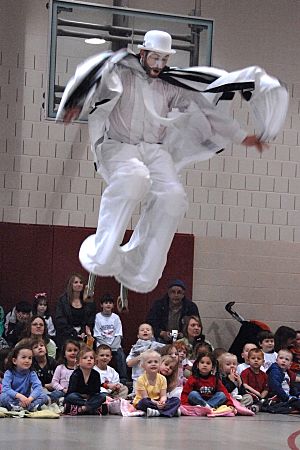
A circus is a special kind of theatre show that involves many physical skills like acrobatics and juggling, and sometimes trained animals. While we often think of a circus as a traveling show in a big tent, it first started in permanent buildings. Philip Astley is seen as the founder of the modern circus in the late 1700s. He brought together performances common at British fairs, like "tumbling, rope-dancing, juggling, and animal tricks."
Magic Tricks
The entertainment known as stage magic or conjuring is based on old traditions of magical rituals and beliefs that have been part of most cultures for a long time.
Stage magic is performed for an audience in many places: on stage, on television, in the street, and at parties or events. It's often combined with other entertainment, like comedy or music. Being a good showman is often key to magic shows. Performance magic uses tricks, psychological manipulation, sleight of hand, and other clever methods to make the audience believe the performer can do impossible things. For example, audiences were amazed by the stunts and escape acts of Harry Houdini, who they thought was a true magician.
Fantasy magicians have been important in stories for centuries, entertaining millions of readers. Famous wizards like Merlin in the King Arthur stories have been written about since the 400s and 500s. In the 2000s, the young wizard Harry Potter became a global hit, with his book series selling about 450 million copies by 2011, making it the best-selling book series in history.
Street Performers

Street entertainment, or "busking," has been entertaining people for hundreds of years. It was a big part of life in London in the early 1800s, for example, when the city was full of shows and fun. Minstrels or troubadours (traveling singers) are part of this tradition. The art of busking is still celebrated at yearly festivals.
There are three main types of street performance today. The first is the "circle show." This kind usually gathers a crowd, has a clear beginning and end, and often involves street theatre, puppeteers, magicians, comedians, acrobats, jugglers, and sometimes musicians. This can be the most profitable for the performer because more people mean more donations if they are entertained. Good buskers know how to control the crowd so people don't block the way. The second type is the walk-by act. This has no clear start or end. The busker usually creates a nice atmosphere, often with an unusual instrument, and people might not stop to watch. Sometimes, a walk-by act turns into a circle show by itself. The third type is café busking, performed mostly in restaurants, pubs, bars, and cafés. This type of act sometimes uses public transport as a place to perform.
Parades and Processions
Parades happen for many reasons, often more than one. Whether they are serious or festive, parades are public events designed to get attention and usually block normal traffic, so they clearly entertain their audiences. Cavalcades (parades with horses) and modern motorcades (parades with cars) are examples of public processions. Some people watching a parade might have planned to go, while others just happen to see it. No matter their mood or main purpose, parades attract and entertain people who watch them go by. Sometimes, a parade takes place in a special area, like the Trooping the Colour in London, where tickets are sold to people watching live, and a global audience watches on TV.
One of the earliest forms of parade was the "Roman triumph"—huge and amazing displays of treasures and spoils from other lands. Victorious Roman generals held them to celebrate their wins. They showed off conquered people and nations, making the general look very important. For example, in 46 B.C.E., Julius Caesar celebrated four triumphs over about a month. In Europe, from the Middle Ages to the Baroque period, the Royal Entry celebrated a monarch's official visit to a city with a parade through decorated streets, passing various shows. The yearly Lord Mayor's Show in London is an example of a city parade that has continued since medieval times.
Many religious festivals (especially those with processions, like Holy Week processions or the Indian festival of Holi) have some entertainment value along with their serious purpose. Sometimes, religious rituals have changed or become secular entertainment. However, pilgrimages, like the Christian Way of St. James, the Muslim Hajj, and the Hindu Kumbh Mela, might look like entertaining parades to outsiders, but they are not meant as entertainment. They are about a person's spiritual journey.
Parades usually impress and delight, often with unusual, colorful costumes. Sometimes they also remember or celebrate something important. Sometimes they have a serious purpose, like military parades that aim to show strength, or religious ones where the audience might join in. Even if a parade uses new technology and is far away, it's likely to be very appealing, grab people's attention, and entertain them.
- Parades – 9 types, six cultures
-
2 Alfred Jacob Miller Cavalcade by the Snake Indians (1858–60)
-
4 Respectful crowd at motorcade in Canada (1945)
-
8 Ganesh Visarjan, Mumbai (2007)
Fireworks Shows
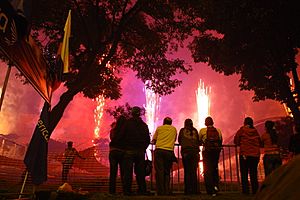
Fireworks are a part of many public entertainments and have been popular for a long time, especially since they became a "crowning feature of elaborate celebrations" in the 1600s. First used in China, ancient times, and Europe for military purposes, fireworks were most popular in the 1700s. Skilled pyrotechnists (fireworks experts), especially Italian ones, were paid high prices and called to other countries to put on displays. Fire and water were important parts of royal court shows because the displays, with their "fire, sudden noise, smoke, and general magnificence," were meant to make people feel awe and respect for their ruler. Birthdays, special days, weddings, and anniversaries were all reasons for fireworks. One of the most famous royal fireworks shows celebrated the end of the War of the Austrian Succession. Even though the fireworks themselves caused a fire, the music written for it by Handel, called Music for the Royal Fireworks, has been popular ever since. Besides celebrating military wins, royal events, and personal parties, fireworks are also used in religious ceremonies. For example, during the Indian Dashavatara Kala of Gomantaka, a temple deity is carried in a procession with lots of singing, dancing, and fireworks.
The "fire, sudden noise, and smoke" of fireworks are still a big part of public celebrations and entertainment. For example, fireworks were one of the main ways the world celebrated the turn of the millennium (the year 2000). As the clock struck midnight and 1999 became 2000, fireworks shows and outdoor parties welcomed the New Year as time zones changed. Carefully planned and choreographed fireworks were set off against the backdrop of many of the world's most famous buildings, including the Sydney Harbour Bridge, the Pyramids of Giza in Egypt, the Acropolis in Athens, Red Square in Moscow, Vatican City in Rome, the Brandenburg Gate in Berlin, the Eiffel Tower in Paris, and Elizabeth Tower in London.
Sports Entertainment
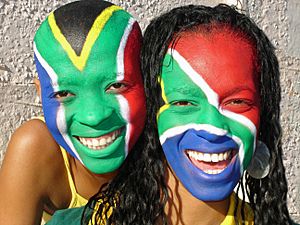
Sporting competitions have always entertained crowds. To tell the players from the audience, the audience members are often called spectators. New designs for stadiums and auditoriums, as well as recording and broadcast technology, have allowed people to watch sports from far away. This has made audiences much larger, and spectator sports have become very popular. Two of the most popular sports worldwide are association football (soccer) and cricket. Their biggest international competitions, the World Cup and test cricket, are shown all over the world. Besides the huge number of people who play these sports, they are a major source of entertainment for millions of non-players globally. A similar long-distance, multi-stage sport with global appeal is the Tour de France, which is unique because it happens outside of special stadiums, running through the countryside instead.
Besides sports that are popular worldwide, like the Olympic Games, how entertaining a sport is depends on the culture and country where it's played. For example, in the United States, baseball and basketball games are popular forms of entertainment. In Bhutan, the national sport is archery. In New Zealand, it's rugby union. In Iran, it's freestyle wrestling. Japan's unique sumo wrestling has special ritual parts that come from its long history. In some cases, like the international running group Hash House Harriers, people create a mix of sport and entertainment for themselves, mostly without spectators, where the social part is more important than the competition.
How an activity becomes a sport and then entertainment is also affected by the local weather and conditions. For example, the modern sport of surfing is linked to Hawaii, and snow skiing probably started in Scandinavia. While these sports and the entertainment they offer have spread worldwide, people in the original countries are still known for their skill. Sometimes the climate allows for adapting another sport, like ice hockey, which is a big entertainment in Canada.
Fairs, Expos, and Shopping
Fairs and exhibitions have been around since ancient and medieval times. They showed off wealth, new inventions, and things to trade, and they offered specific entertainments while also being entertaining places themselves. Whether in a medieval market or a small shop, "shopping always offered forms of excitement that took one away from the everyday." However, today, "shopping has become entertainment: spinning signs, flashing signs, loud music... video screens, interactive computer kiosks, day care... cafés."
By the 1800s, "expos" that promoted arts, manufacturing, and trade became international. They were not only hugely popular but also influenced ideas worldwide. For example, the 1878 Paris Exposition helped countries work together on ideas, inventions, and standards. From London in 1851 to Paris in 1900, "over 200 million visitors had entered the turnstiles in London, Paris, Vienna, Philadelphia, Chicago, and many smaller shows around the world." Since World War II, "well over 500 million visits have been recorded through world expo turnstiles." As a form of spectacle and entertainment, expositions influenced "everything from architecture, to how countries connect globally, to basic ideas about who we are." In doing so, they created a close link between "fairs, the rise of department stores, and art museums," the modern world of mass buying, and the entertainment industry.
- Entertainment in expositions and shops
-
Ball pit of the type provided for children's entertainment in shopping malls
Images for kids
-
Albert Bierstadt's The Campfire shows storytelling, a universal form of entertainment.
-
Mosaic showing Roman entertainments that would have been offered at the gladiatorial games, from the 1st century.
-
Comedian Charlie Chaplin pretending to be Adolf Hitler for laughs in the satirical film The Great Dictator (1940).
-
The Boyhood of Raleigh by Sir John Everett Millais, oil on canvas, 1870. A sailor tells young Sir Walter Raleigh and his brother a story about the sea.
-
An artificial castle in Disneyland amusement park.
-
A magazine advertisement for a crystal radio (1922).
-
1 Toy Coldstream Guards soldiers (19th century).
-
4 A French scout (early 20th century).
-
6 Armenian boys playing recorders.
-
10 A toddler using a Tablet computer.
-
1 A banquet scene from Ancient Egypt (from a wall painting in Thebes).
-
2 Byzantine banquet showing musicians and various musical instruments (1204–1453).
-
3 Jean Fouquet, Banquet for Charles V of France (1455–1460).
-
5 Bartholomeus van der Helst, Peace of Münster Amsterdam (1648).
-
6 Victory banquet by Emperor Qian Long to greet the officers who attended the campaign against Taiwan. (late 18th century).
-
8 The banquet hall in the palace of King Sahle Selassie painting from a photo, Ethiopia (1852).
-
9 Coronation banquet of George IV in Westminster Hall (1821).
-
10 Chinese banquet in a banquet hall given as a birthday celebration (2012).
-
2 Children's choir providing musical entertainment (Soviet Union, 1979).
-
3 Ensemble entertains travellers in the Paris Métro (2002).
-
5 Choir and orchestra in ecclesiastical setting (Italy, 2008).
-
Sofonisba Anguissola The Chess Game (1555) An intellectual game.
-
Théophile Emmanuel Duverger (before 1901) Hopscotch A physical game.
-
William Blake's painting of the pilgrims in The Canterbury Tales.
-
Scheherazade telling her stories to King Shahryar in The Arabian Nights.
-
Telling stories via Wayang golek puppets in Java.
-
Tosa Mitsuoki illustrating her Tale of Genji.
-
6 An outdoor theatre made from the front area of Edinburgh Castle.
-
7 A traditional stage for Japanese Noh theatre.
-
9 Teatro Colón, a very fancy, horseshoe-shaped theatre.
-
3 Ballroom dancing (Czech Republic).
-
4 Belly dancer (Morocco).
-
5 Morris dancing (England).
-
6 Highland wedding (Scotland, 1780).
-
8 Fire Dragon dance for Chinese New Year.
-
9 Bhangra dancers at the International Children's Festival.
-
Trained monkey performing for an audience of children (1900–20).
-
Crowd watches Pharlap win the Melbourne Cup in Australia, 1930.
-
A ticket showing an electronic barcode (Valencia, 2005).
-
The Grand Foyer in the Palais Garnier, Paris (1875), which influenced architecture around the world.
-
Maracanã, Rio de Janeiro, at its opening (1950), the world's largest stadium by capacity.
-
The O₂ entertainment precinct, London (2007).
-
Flamingo Entertainment Centre, Vantaa (2008), includes various entertainment activities (e.g., a movie theater, spa, bowling, laser games, virtual experiences), 40 different stores, and a hotel.
See also
 In Spanish: Entretenimiento para niños
In Spanish: Entretenimiento para niños


